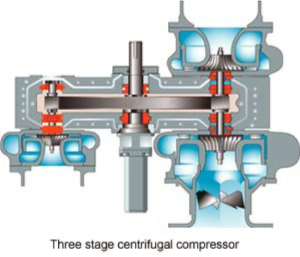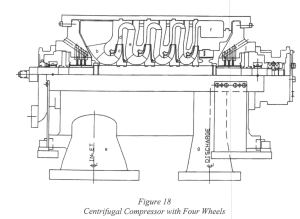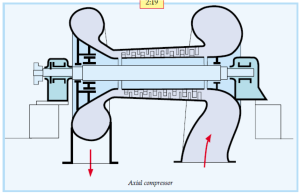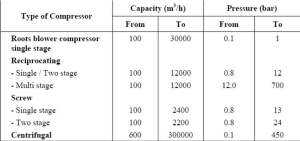Part 4 – Dynamic Compressors
Dynamic Compressors

Video: Centrifugal Compressors
Watch the video


Centrifugal Compressors use a rotating disk or impeller in a shaped housing to force the gas to the rim of the impeller, increasing the velocity of the gas. A diffuser (divergent duct) section converts the velocity energy to pressure energy. They can use from 100 hp (75 kW) to thousands of horsepower. With multiple staging, they can achieve extremely high output pressures greater than 10,000 psi (69 MPa). Speed is very high compared with other types of compressor, 15,000 – 100,000 r/min are common.
Main types of casing types for multistage centrifugal compressors:
- Horizontally split type- Top half of the casing can be removed for maintenance.
- Barrel type– For very high pressures.The casing is a one piece, cylindrical casting into which the compressor parts are placed. The casing is of thicker wall construction at the discharge end for added strength.

Advantages |
Disadvantages |
|
|
Axial Flow Compressors
Can handle large flow volumes in relatively small casings. Produce pressures up to 400 kPa. Flow volumes range from 40,000 and 1,000,000 m3/h. Use arrays of fan-like aerofoils to progressively compress the working fluid. Used where there is a requirement for a high flows or a compact design.
Video: 3D animation of axial flow compressor working principle
Watch “3D animation of axial flow compressor working principle” [4:18].

Dynamic Compressors
Axial flow compressors are almost always multi-staged. They have high efficiencies and around 90% polytropic at their design conditions. However, they are expensive and require a large number of components, tight tolerances and high quality materials. They are generally found in medium to large gas turbine engines, in natural gas pumping stations, and within certain chemical plants.
Scroll Compressors
Video: Scroll Compressor
Watch “Scroll Compressor” [2:58].
Scroll compressors use two interleaved spiral-like vanes to pump or compress fluids such as liquids and gases. The vane geometry may be involute, archimedean spiral, or hybrid curves. They operate more smoothly, quietly, and reliably than other types of compressors in the lower volume range.
Activity: Images of Scroll Compressors
Click the arrows to view a Scroll Compressor Operating.
Diaphragm Compressors
Similar to reciprocating compressor. The only compression of gas occurs by the movement of a flexible membrane. Only the membrane and the compressor box come in touch with the gas being compressed.
Video: Diaphragm Compressor
Watch the short video “Diaphragm Compressor Animation” [0:14].
Comparing Compressors

Reciprocating Compressors
Reciprocating Compressors can be:
-
- Stationary or portable
- Single or multi-staged
- Driven by electric motors or internal combustion engines.
Video: Reciprocating Compressors
Watch the video ” Reciprocating Compressor Principles” [3:17].


